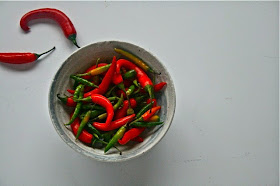Preserving olives
is a rewarding experience. If you don’t have an olive tree you may be able to
forage olives from trees in community gardens and in parks. Usually olives are ready around April-May (in New Zealand).
Pick the olives from the tree (never from the ground)
and wash well in cold water. If you prefer sweet-tasting olives you can put
them in a bucket of water for up to 40 days, or 20-30 days for very small
olives, changing the water every 24 hours; the olives will become brownish in
colour, and lose a lot of bitterness. After this period make a brine (recipe
follows) and bttle your olives. If you prefer crispy green olives with a
peppery taste, just wash them and soak them for a day, then preserve them in
brine.
Brine for preserving olives
Before making the brine, be sure to have plenty of
glass jars with lids, sterilised and completely dry.
Ingredients
Water
Salt
Prepare 10% salt brine (100 g of salt for every litre
of water) by placing in a saucepan the water and salt. Simmer until the salt is completely
dissolved. Once the brine is cold place the olives into clean sterilised jars
and cover completely with the brine.
To each jar add one more clove of garlic, a fresh bay
leaf, a chilli pepper, or a fresh sprig of thyme. Seal and put away in a dark place for three months. After
this period the olives can be used in cooking or can be marinated with olive
oil and your favourite herbs.
If you’d like to keep the olives for longer prepare a
new brine with an 8% solution (80 g of salt every for every litre of water) and
put the olives into new jars with the fresh brine (discard the old brine). Olives stored this way, and
completely covered with brine, will last for years! Don't worry if you see
white spots forming at the top of the brine, as this is natural — just remove
them every time you open the jar, and always rinse the olives before using. Below is a recipe for marinating your preserved olives with olive oil and herbs, starting with your olives in brine.
Olives marinated in olive oil and herbs
I suggest you use a delicate olive oil for this recipe, like an extra virgin olive oil from the supermarket. Expensive olive oil is far too precious to marinate olives, unless you have your own press.
Ingredients
300 g olives in brine (green or dark)
1 sprig fresh thyme
1 sprig fresh oregano
1 sprig fresh rosemary
6 peppercorns
200 ml extra virgin olive oil
Drain the olives well from the brine, and give them a little rinse. Place in a large jar, add the herbs and pepper corns, and cover with the oil. Leave to rest for at least one day, and then serve. Store in a cool place and use within two weeks.
Photos and Recipes by Alessandra Zecchini ©































